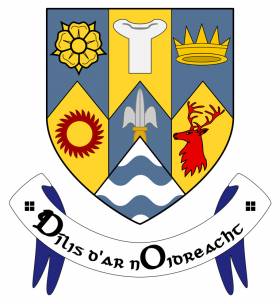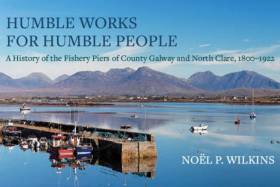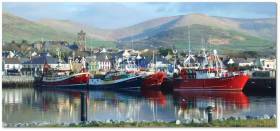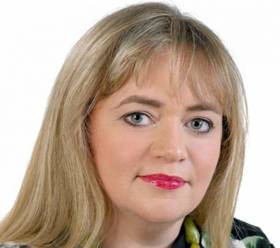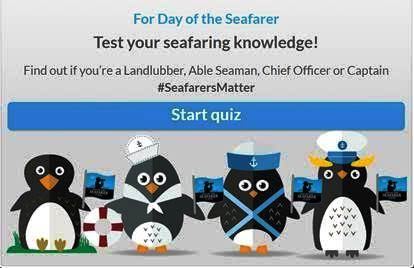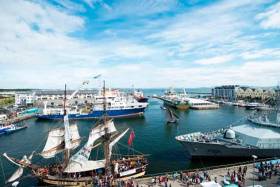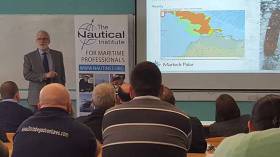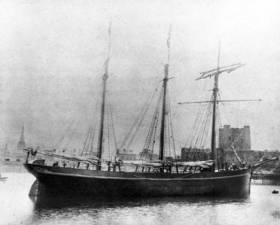Displaying items by tag: maritime
Atlantic Youth Project Gets €388k To Boost Maritime Opportunities for Clare’s Young People
In partnership with four other EU local authority areas Clare County Council has received European Union (EU) funding totalling €388,000 to increase participation in maritime activities and to encourage young people across Clare to consider maritime related careers.
The Local Authority’s Social Development Directorate, through its remit to increase overall participation levels in sport and physical activity in Clare, has been awarded the EU Erasmus+ programme funding as part of the ‘Atlantic Youth Project’.
“As the only Irish partner in the European-wide project, Clare County Council is tasked with encouraging and developing the maritime culture of young Europeans, through the practise of water sports and maritime education at school,” explained Tim Forde, Head of Sport & Recreation, Clare County Council.
He continued, “Over the three-year term of this project, the Local Authority will facilitate the involvement of a significant number of second level school children with opportunities to participate in water sports in our county whilst also participating in organised maritime education opportunities that will be EU-funded.”
Mr. Forde and Liam Conneally, Director of Social Development, Clare County Council, represented the Local Authority at the project launch and inaugural meeting of the participating partners which was held recently in Viana do Castelo, Portugal, home to the Lead Partner, Cim Alto Minho.
Mr. Conneally noted that Clare had been selected to participate in the ‘Atlantic Youth Project’ due to its “ready access to sea and river waters surrounding the County, maritime heritage, existing maritime infrastructure for hosting project activities, and Clare County Council’s lengthy track record of delivering education outreach programmes.”
“With partners in Spain, Portugal, France, UK and Ireland (Clare County Council), the Atlantic Youth Project will also contribute to the implementation of the EU’s Atlantic Maritime Strategy, through the development of a maritime culture among young people which in turn will encourage the upcoming generation to consider maritime sport, recreation and industry as a career path,” he added.
Over the coming months Clare County Council will be working with sporting and educational stakeholders across the County and will confirm details of the rollout of the ‘Atlantic Youth Project’ in County Clare in early 2018.
Humble Works for Humble People: The History of Fishery Piers & of Galway & North Clare
This beautifully illustrated book explores the history of the fishery piers and harbours of Galway and North Clare. A testament to these structures as feats of engineering, it is also a riveting account of the human aspect that shadowed their construction; a beautiful rendering of the maritime activities that gave life to the Wild Atlantic Way – kelp-making, fishing, turf distribution, and sea-borne trade.
Humble Works for Humble People nurtures the retelling of human stories surrounding the piers, giving voice to the unacknowledged legacy of the lives that were their making. Foreign financial support, humanitarian efforts, controversies and conflict – these are all features of the piers and harbours’ development and preservation. Humble Works for Humble People is a vital contribution to the maritime history of Galway, Clare and of Ireland in general; an overlooked but culturally rich facet of Irish history.
Buy the book online from Afloat.ie's Marine Market here.
Dingle Maritime Weekend: October 28th-29th 2017
Dingle today is closely associated with superb hospitality, good food, the sporting entertainment of the biennial Dun Laoghaire to Dingle Race, and the eternal sense of the nearby presence of the mighty Atlantic in one direction, and majestic mountains soaring to the peak of Mount Brandon in the other. Thus it is easy to overlook the fact that this remote yet spirited and independent port has a long history of interacting with the sea for fishing, international trade, and other intriguing activities writes W M Nixon.
The annual Dingle Maritime Weekend in the October Bank Holiday Weekend has been running for six years now to increase awareness of Dingle’s often colourful maritime past. It was established by Kevin Flannery of Dingle Oceanworld and former Harbour Master Captain Brian Farrell (whose tour of duty did so much to bring the harbour to its present healthy state), and the idea is to exlore aspects of that rich heritage, and how it relates to Dingle’s fascinating maritime environment today.
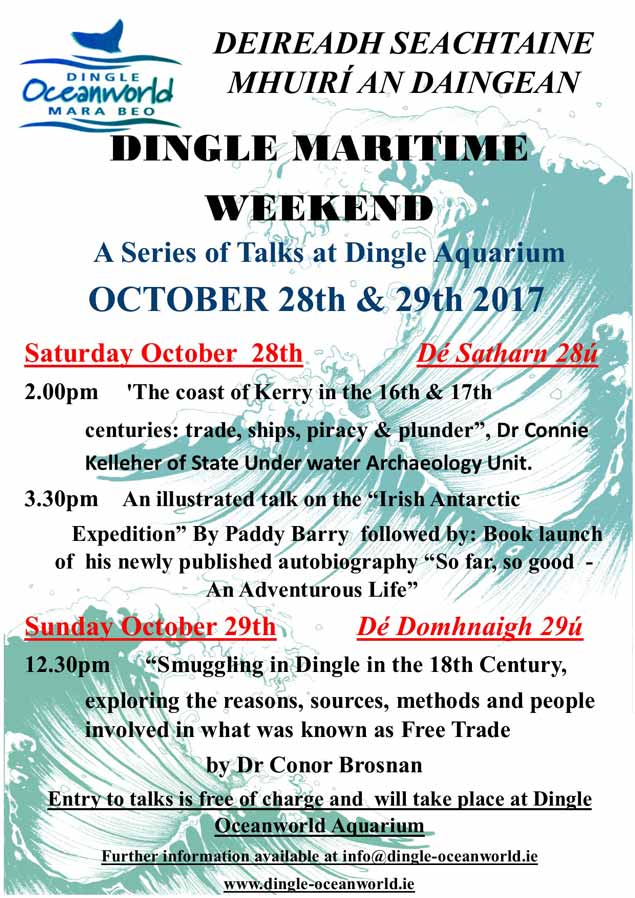
It’s held at the Oceanworld Aquarium and admission is free for three special talks spread in civilized style between the Saturday afternoon and early Sunday afternoon. Thus it’s a user-friendly format which means you can combine the usual multi-activity Dingle holiday weekend with some digestible maritime information. But of course with the varied audience which it usually attracts, all sorts of post-presentation conversations can happily arise.
Dingle Maritime Weekend Programme, 28th and 29th October 2017 at Oceanworld Aquarium
SATURDAY 28th OCTOBER 14:00hrs
'The coast of Kerry in the 16th and 17th centuries: trade, ships, piracy and plunder.'
by Dr Connie Kelleher
The talk will draw on sources such as the High Court of Admiralty Papers, State Papers and other contemporary sources to illustrate episodes when the expansion of maritime empires meant that the diversity of goods traded encouraged smuggling, piracy and corruption. It will show that harbours like Dingle, Ventry and Valentia, rather than being remote, formed part of a network central to this global development in commercial shipping, colonial enlargement and associated growth in opportunistic plunder.
DR CONNIE HELLEHER is a member of the State Underwater Archeology Unit in the National Monuments Service Department of Culture, Heritage and the Gaeltacht. Connie is a graduate of UCC with an MA in maritime archaeology and a PhD from Trinity College Dublin on the history and archaeology of piracy in Irish waters in the early 17th century. As a commercially trained diver, her work with the NMS is broad and focuses on the protection of Ireland's underwater cultural heritage. She is visiting lecturer in underwater archaeology in the Archaeology Dept UCC and is a Board member of the international advisory council on underwater archaeology. With several papers and chapters published on piracy in Irish waters, she is currently putting the final edit to her book: “Ireland's Golden Age of Piracy”.
SATURDAY 15:30 hrs
Irish Antarctic Expedition.
PADDY BARRY will give an illustrated talk on the Irish Antarctic Expedition which followed the survival route of Shackleton & Tom Crean by sea in a small boat and then over the mountains of South Georgia.
 The national hero from the Dingle Peninsula – Tom Crean in the Antarctic.
The national hero from the Dingle Peninsula – Tom Crean in the Antarctic.
Tom Crean came from Annascaul on the Tralee to Dingle road, and is one of the Dingle Peninsula’s most internationally-noted historic figures (another is film star Gregory Peck).
Paddy Barry is a Civil Engineer, now retired, who has, during his working life, taken many 'career breaks' to sail to out of the way places, while at the same time somehow maintaining domestic relations on the home front. He lives in Monkstown, Dublin and has worked, apart from Ireland, in the UK, the USA, Malawi and Ethiopia. His first 'big' trip was to America, in the Galway Hooker ' Saint Patrick', followed in the same boat by journeys to Spitsbergen and later to North West Greenland.
 High latitudes voyager and explorer Paddy Barry will celebrate the Dingle Peninsula’s links to Tom Crean
High latitudes voyager and explorer Paddy Barry will celebrate the Dingle Peninsula’s links to Tom Crean
In a very much smaller boat he was Skipper of the Irish Antarctic team which followed in the wake of Shackleton's small boat journey. In 2001 he was Expedition Leader of the team who traversed the North West Passage in the vessel 'Northabout'.
Paddy in his sailing boat Ar Seachrán escorted Camino Thar Sáile on its first year of voyaging across the Irish Sea and the Channel to Europe.
Paddy’s talk will be followed by the Kerry Launch of his newly published autobiography, “So Far, So Good – An Adventurous Life”. Available to purchase here.
SUNDAY 29th October 12:30hrs
Smuggling in Dingle in the Eighteenth Century
Speaker Dr Conor Brosnan
DR CONOR BROSNAN will discuss smuggling in Dingle in the eighteenth century. He will explore the reasons, sources, methods and people involved in what was known as Free Trade. He will talk on the methods the authorities used to suppress smuggling and the legacy it left.
Dr Conor Brosnan is a local GP and a member of Dingle Historical Society. He has a deep interest and knowledge of the Dingle area and its history.
Mairéad Ní Cheóinín Appointed to Seafarers UK Fundraising Role
Mairéad Ní Cheóinín has been appointed to Seafarers UK as the charity’s new Corporate Fundraising Manager where her focus will be on engaging with the commercial maritime sector.
Mairéad brings a wealth of business development, marketing experience and industry knowledge to the position from her previous roles, working with Steamship Mutual P&I, TradeWinds, Informa PLC in London and the Irish Maritime Development Office in Dublin.
Mairéad joins the grant-giving, campaigning and fundraising charity at an exciting time, as it celebrates its Centenary and is looking ahead to the next phase of its future. Her role will be to raise awareness of Seafarers UK’s wider impact within the maritime charity sector.
Seafarers UK aims to increase financial support for its charitable work through encouraging participation in corporate donations, employee fundraising, challenge events and payroll giving, as well as funding support for specific projects.
Last year Seafarers UK awarded £2.57 million in funding to 69 organisations and projects, helping more than 185,000 people in the process. For more information about Seafarers UK’s work or any of its fundraising or donation initiatives please visit www.seafarers.uk
Commenting on her appointment Mairéad Ní Cheóinín said ‘I am honoured to join Seafarers UK at this juncture. It is vitally important to maintain awareness within the maritime and fishing sectors of the contribution Seafarers UK has made and continues to protect and provide for the welfare of past, present and future seafarers. I am looking forward to promoting all the great work and initiatives Seafarers UK supports to our existing and new corporate partners and donors.’
Nigel Shattock, Seafarers UK’s Director of Fundraising & Communications, said ‘I am very pleased to be able to announce Mairéad’s appointment. The Seafarers UK team is looking forward to working with Mairéad in her role of reaching out to the wider maritime sector and asking firms and their staff to get to know our unique charity better, and to work with us in achieving our goals of helping seafarers in need, supporting maritime youth and in raising awareness of the opportunities that this fantastic sector has to offer.’
Government Ignores United Nations Honouring of Seafarers
On my PODCAST this week I am dealing with three particular subjects – the Government’s lack of interest in the United Nations honouring of seafarers this Sunday; concern in coastal communities from where there are claims that senior officials in the Department of the Marine have threatened fishermen that another cut in the size of the Irish fishing fleet will be forced upon them, with or without their agreement – and water shortages on West of Ireland offshore islands caused, their community representative association claims, by a quarter-century of neglect of the needs of these communities to enable them to continue living on the islands.
The International Maritime Organisation, which is the United Nations body for the sea, of which Ireland is a member, has not listed Ireland as officially marking Sunday next, June 25, as INTERNATIONAL DAY OF THE SEAFARER, with the theme “SEAFARERS MATTER.” It is to be hoped that there will be individual efforts to remember the seafarers but it is a poor example by the State that an island nation, dependent for 95 per cent of its exports and imports on ships, shipping and seafarers, cannot officially run at least one national day in the year to show appreciation for seafarers. We will be pleased at AFLOAT to hear of events anywhere around Ireland.
There is a lot of concern in coastal communities about the future of the fishing industry amid fears that the Government is trying to force through another reduction in the Irish fleet, by cutting the number of boats to satisfy EU pressure, which gives a vastly bigger entitlement to catch fish in Irish waters to the bigger EU nations than Irish boats can catch in our own waters. That’s an issue I took up with the Minster for the Marine, Michael Creed, when I asked him if the Government is giving enough priority to maritime matters.
You can hear his response on the PODCAST below:
Galway Business Backs Seafest Maritime Festival
Businesses across Galway and the region are giving their support to SeaFest 2017, with festival activities extending from Galway Harbour to The Latin Quarter and Salthill.
SeaFest 2017 is Ireland's national maritime festival and will include a variety of marine-themed activities and attractions to celebrate the sea from 30 June to 2 July 2017.
Dr Peter Heffernan CEO of the Marine Institute said the involvement of businesses across Galway and the region is vital to the success of SeaFest 2017.
"The marine sector is of major value to the Irish economy and coastal communities and offers significant potential for growth. It is essential for businesses, organisations and communities connected with our ocean to be part of SeaFest," Dr Heffernan said.
For the first time, SeaFest will welcome the contribution of the Western Development Commission (WDC) to the 2017 event.
"The WDC are delighted with the opportunity to participate in SeaFest," said Ian Brannigan CEO of the WDC. "At SeaFest we are setting out to showcase businesses in the West of Ireland who take their inspiration from Ireland's ocean. Mr Brannigan said.
The Galway Chamber of Commerce will also support SeaFest 2017 by working with businesses across Galway, particularly The Latin Quarter Galway and Salthill, to develop a programme of activities.
"Salthill offers stunning views of Galway Bay, and is the ideal location to feature water sports and hold family-friendly activities along the shore," Dr Heffernan said. "SeaFest is also an opportunity to highlight the host of quality eateries in The Latin Quarter Galway, including some of the city's finest seafood restaurants serving locally sourced produce."
As well as the three-day festival, a range of industry events will be held as part of SeaFest 2017. National and international delegates will attend Our Ocean Wealth Summit on 30 June at NUI Galway. Digital Ocean: Ireland's Marine Engineering and Technology Conference and the Marine Industry Awards will take place on 29 June. A Marine Trade Show will also be held at NUI Galway on 29 and 30 June, to run in parallel with the Our Ocean Wealth Summit and Digital Ocean events.
SeaFest is co-ordinated by the Marine Institute, on behalf of the Marine Coordination Group.
The President of the Nautical Institute, the worldwide representative organisation for maritime professionals has told its Irish branch that reality must be separated from the myths about shipping using Polar waters writes Tom MacSweeney.
Capt. David (Duke) Snider from Canada has written the Institute's book on ice navigation 'Polar Ship Operations'. He told Institute members at a meeting in the National Maritime College in Cork that the vast majority of operators in Polar waters had a lot of experience and were "long-term" players in the region.
It was a myth that "wild cowboys" of shipping were "roaring through the Arctic polluting and destroying the environment". He said that global climate change had opened up the Arctic. Change was visual and real.
The Polar Code has been introduced by the International Maritime Organisation. It did not have everything in it that everyone wanted but it was a start and more work was necessary and would be done on it.
The Marine Institute & IMERC Win Award for Technology Cluster Work
The Marine Institute and IMERC have been presented with the International Maritime Partner award by the Maritime Alliance. The Irish marine science organisation received their award from San Diego-based non-profit industry association The Maritime Alliance (TMA) at the annual Blue Tech & Blue Economy Summit in San Diego (Wednesday 9th November).
The Marine Institute and IMERC were selected for this international award for their work in developing Ireland's marine technology cluster. The Entrepreneur Ship was recently launched as part of the IMERC cluster at their campus in Cork, providing space for companies in areas such as robotics, big data, biotechnology, power generation, cyber security, unmanned systems and power storage as they relate to our ocean and energy systems. The Marine Institute's National Marine Technology Programme and associated SmartOcean initiative promotes the development of high value products and services by creating a critical mass of research and development activities in marine information, communication and technology by developing a marine technology innovation cluster.
In addition to receiving the Award, Dr Edel O'Connor of the Marine Institute gave a keynote address on Ireland's national ocean economy strategy at the Blue Tech and Blue Economy Summit. This five day event brings together over 400 professionals, investors, educators, and government officials to collaborate on issues, engage in key topics and develop partnerships that promote BlueTech blue jobs.
Speaking about the award, Dr Peter Heffernan, CEO of the Marine Institute said:
"Ireland has been gaining a reputation in Europe, and internationally for its marine research and innovation, and for driving collaboration in this area. This award by the Maritime Alliance shows the high regard for the work we are doing in Ireland with our colleagues at IMERC to bring together marine innovators and create an environment that promotes collaboration to develop BlueTech solutions for a global market."
The award by the Maritime Alliance is the second award the Marine Institute has received for international collaboration in recent months. The Atlantic Project Award for International Cooperation was presented to Dr. Heffernan and Dr. Margaret Rae, Marine Institute for the Horizon 2020 funded Atlantic Ocean Research Alliance Co-ordination and Support Action (AORA-CSA). Strategy, innovation, implementation, results and relevance to the Atlantic Strategy all formed part of the award criteria. Karmenu Vella, European Commissioner for Environment, Maritime Affairs and Fisheries presented the award at the Atlantic Stakeholders Conference, Dublin, 7 September 16.
The Marine Institute is the lead partner in the Atlantic Ocean Research Alliance Co-ordination and Support Action project to implement the Galway Statement on Atlantic Ocean research cooperation. This initiative aims to promote better collaboration on research activities and sharing of marine data and ocean observation infrastructure and has already delivered results, particularly in Atlantic Ocean mapping, including the mapping of ocean transects between St. John's Newfoundland and Galway on Ireland's national research Vessel, Celtic Explorer in June last year and May this year.
An all-day Belfast–based conference this month entitled 'Our Maritime Heritage: Research, Resources and Restoration' is taking place at Public Record Office of Northern Ireland (PRONI). The first 65 delegates to register here will receive a complimentary lunch. A keynote speaker is Afloat.ie correspondent Marcus Connaughton, the RTE presenter of Seascapes that is podcasted weekly on Afloat.ie.
The conference Thursday 20 October 2016 beginning at 9.30 am and running to 6.00 pm.
The conference explores national, local and individual responses to how we protect our maritime heritage.
This joint conference has been organised by the Public Record Office of Northern Ireland (PRONI), Titanic Foundation Limited, HMS Caroline, National Historic Ships UK, Gerry Brennan (Silvery Light Sailing) and Robin Masefield (author).
The conference explores national, local and individual responses to how we protect our maritime heritage.
Conference at PRONI: 9.30 am-4.15 pm
The conference will commence with a keynote address by Marcus Connaughton, presenter of RTÉ Radio 1’s maritime programme ‘Seascapes’, and Hannah Cunliffe, National Historic Ships UK. Speakers include Gerry Brennan on the Silvery Light project; Christopher Kenny on the schooner Result; Sean Patterson on the Newry Canal and Fishers’ Fleet, Kerrie Sweeney on the development and restoration work on the Harland and Wolff Drawing Offices; Dr Sally Montgomery on the history of Mew Island Lighthouse Optic and its restoration; and Desmond McCabe on maritime research in PRONI archives. Other topics will include the restoration of HMS Caroline, and obtaining project funding. The conference will conclude with an open panel discussion.
Lunch: SS Nomadic
Lunch will be provided on SS Nomadic for the first 65 delegates to register. Remaining delegates will be invited to make their own lunch arrangements.
HMS Caroline visit: 4.15 pm – 6.00 pm
Conclude the day with a visit to HMS Caroline (maximum 80 delegates).
You can see a link for the this event on Afloat's Marine marketplace here
Marine Wildlife & Lighthouses Feature in Responsible Tourism Awards
Maritime tourism operators featured at the 2016 Irish Responsible Tourism Awards announced at a ceremony yesterday in Dublin.
In the best for Natural Heritage Tourism category, a silver award went to Sea Synergy Marine Awareness & Activity Centre (Co. Kerry). The marine interpretive centre located in the heart of the coastal village Waterville displays interactive displays on Ireland's marine life, such as turtles, sharks, swordfish, bones from whales and dolphins.
In the best Innovation in Responsible Tourism, the Great Lighthouses of Ireland was another Silver award winner. The tourism initiative, is a new all-island tourism initiative, developed by the Commissioners of Irish Lights and features twelve lighthouses in breathtaking coastal locations. The project offers visitors from home and abroad the chance to visit or stay in a lighthouse, to find out about their history, to appreciate the spectacular natural world around them.
The awards are a response to demand from the Irish trade for a new type of awards showcasing the best in Irish responsible tourism. The 2016 Irish Responsible Tourism Awards aim to inspire replication, to excite media interest, to encourage competition and celebration from across the tourism industry on the island of Ireland.
The Irish Responsible Tourism Awards are part of a growing family of worldwide responsible tourism awards which are all linked to the World Responsible Tourism Awards, founded by responsibletravel.com. Winners of each of the categories will be longlisted for the World Responsible Tourism Awards - a great opportunity for the Irish trade to raise international awareness.
The shortlist for the awards, which attracted entries from almost every county in Ireland, was announced in early September following assessment by a panel of industry experts chaired by international responsible tourism expert Professor Harold Goodwin. The award categories and the winners of the Silver & Gold awards are:
Best for Natural Heritage Tourism
· GOLD: Doolin Cave (Co. Clare)
· SILVER: Burren Nature Sanctuary (Co. Galway)
· SILVER: Sea Synergy Marine Awareness & Activity Centre (Co. Kerry)
Best for Accessible & Inclusive Tourism
· GOLD: Gleneagle Hotel Group (Co. Kerry)
· SILVER: Mobility Mojo
Best Local Authority Initiative for Responsible Tourism
· GOLD: Lough Muckno - Monaghan County Council
· SILVER: Westport Smarter Travel Bike Buffet - Mayo County Council
Best Tourism Accommodation for Local Sourcing
· GOLD (joint): Sea View House (Co. Clare) and Fuchsia Lane Farm Holiday Cottages (Co. Tipperary)
· SILVER: Hotel Doolin (Co. Clare)
Best Destination for Responsible Tourism
· GOLD: Mulranny (Co. Mayo)
· SILVER: Inishbofin Island (Co. Galway)
· SILVER: Sheep’s Head Way (Co. Cork)
Best Innovation in Responsible Tourism
· GOLD: The Blackfriary Community Heritage and Archaeology Project (Co. Meath)
· SILVER: Great Lighthouses of Ireland
Overall Winner: Mulranny (Co. Mayo)
Judges for the awards include:
Catherine Mack (responsibletravel.com)
Kevin Griffin (DIT tourism lecturer and former-EDEN awards judge)
Paddy Mathews (Fáilte Ireland)
Annabel Fitzgerald (Irish Water & formerly Coastal Programmes Manager An Taisce)
Mark Henry (Central Marketing Director, Tourism Ireland)
Cyril McAree (Managing Director, Hotel & Restaurant Times)
Fáilte Ireland’s Head Investment & Innovation, Paddy Matthews said, “A more environmentally conscious and community-centred approach to developing tourism in Ireland is becoming more and more mainstream... and so it should. It results in more genuine and authentic experiences for all our visitors.”
The awards took place at the 3nd Irish Responsible Tourism Conference organised by the Irish Centre for Responsible Tourism. The Irish Centre for Responsible Tourism was established in 2013 to promote responsible tourism on the island of Ireland





























